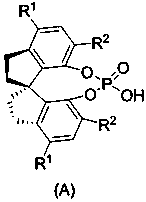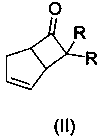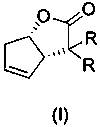Synthesis method of (1S, 5R)-lactone
A synthesis method and technology of lactone, applied in the field of synthesis of (1S,5R)-lactone, can solve the problems of limited industrial application prospects, insufficient catalytic efficiency, low enantioselectivity, etc., and achieve high enantioselectivity Catalytic effect, low cost, high chemical yield and high optical purity
- Summary
- Abstract
- Description
- Claims
- Application Information
AI Technical Summary
Problems solved by technology
Method used
Image
Examples
Embodiment 1
[0023] Example 1: 7,7-dichlorobicyclo[3.2.0]hept-2-en-6-one (1.77g, 0.01 mol), (11aR)-10,11,12,13-tetrahydro-5 -Hydroxy-3,7-bis[2,4,6-triisopropylphenyl]-5-oxo-diindene[7,1-de:1',7'-fg][1,3,2 ] Phosphonic acid dioxide (0.35 g, 0.005 mmol), 30% aqueous hydrogen peroxide solution (2.5 mL, 0.03 mol) and chloroform (20 mL) were placed in a dry reaction flask, and stirred at -20°C~0°C for 36~72 hours. After the reaction was completed, the solvent was recovered under reduced pressure, cooled to room temperature, diethyl ether (50 mL) was added to the residue and stirred for 15 min, then 10% hydrochloric acid (50 mL) was added and stirred for 30 min, left to stand, the organic layer was separated, and dried over anhydrous sodium sulfate . Filtration, the filtrate was recovered under reduced pressure, and a solid was precipitated, dried to obtain a white powder, and recrystallized from ether to obtain the product II (R=Cl, 46%, ee value 96.9%). 1 H NMR (CDCl 3 ): = 5.99 (s, 1H), ...
Embodiment 2
[0024] Example 2: 7,7-dichlorobicyclo[3.2.0]hept-2-en-6-one (1.77g, 0.01 mol), (11aR)-10,11,12,13-tetrahydro-5 -Hydroxy-3,7-bis[2,4,6-triisopropylphenyl]-5-oxo-diindene[7,1-de:1',7'-fg][1,3,2 ] Dioxyphosphonic acid (0.35 g, 0.005 mmol), 30% hydrogen peroxide solution (2.5 mL, 0.03 mmol) and chloroform (20 mL) were placed in a dry reaction flask, and stirred at -40°C~-20°C for 48~72 hours . After the reaction was completed, the solvent was recovered under reduced pressure, cooled to room temperature, diethyl ether (50 mL) was added to the residue and stirred for 15 min, then 10% hydrochloric acid (50 mL) was added and stirred for 30 min, left to stand, the organic layer was separated, and dried over anhydrous sodium sulfate . Filtration, the filtrate was recovered under reduced pressure, and a solid was precipitated, dried to obtain a white powder, and recrystallized from ether to obtain the product II (R=Cl, 46%, ee value 96.9%). 1 H NMR (CDCl 3 ): = 5.99 (s, 1H), 5.74 (s,...
Embodiment 3
[0025] Example 3: 7,7-dichlorobicyclo[3.2.0]hept-2-en-6-one (1.77g, 0.01 mol), (11aR)-10,11,12,13-tetrahydro-5 -Hydroxy-3,7-bis[2,4,6-triisopropylphenyl]-5-oxo-diindene[7,1-de:1',7'-fg][1,3,2 ] Phosphonic acid dioxide (0.35 g, 0.005 mmol), 30% aqueous hydrogen peroxide solution (2.5 mL, 0.03 mmol) and chloroform (20 mL) were placed in a dry reaction flask and stirred at -20°C to 20°C for 36 to 72 hours. After the reaction was completed, the solvent was recovered under reduced pressure, cooled to room temperature, diethyl ether (50 mL) was added to the residue and stirred for 15 min, then 10% hydrochloric acid (50 mL) was added and stirred for 30 min, left to stand, the organic layer was separated, and dried over anhydrous sodium sulfate . Filtration, the filtrate was recovered under reduced pressure, and a solid was precipitated, dried to obtain a white powder, and recrystallized from ether to obtain the product II (R=Cl, 46%, ee value 96.9%). 1 H NMR (CDCl 3 ): = 5.99 (s...
PUM
 Login to View More
Login to View More Abstract
Description
Claims
Application Information
 Login to View More
Login to View More - R&D
- Intellectual Property
- Life Sciences
- Materials
- Tech Scout
- Unparalleled Data Quality
- Higher Quality Content
- 60% Fewer Hallucinations
Browse by: Latest US Patents, China's latest patents, Technical Efficacy Thesaurus, Application Domain, Technology Topic, Popular Technical Reports.
© 2025 PatSnap. All rights reserved.Legal|Privacy policy|Modern Slavery Act Transparency Statement|Sitemap|About US| Contact US: help@patsnap.com



